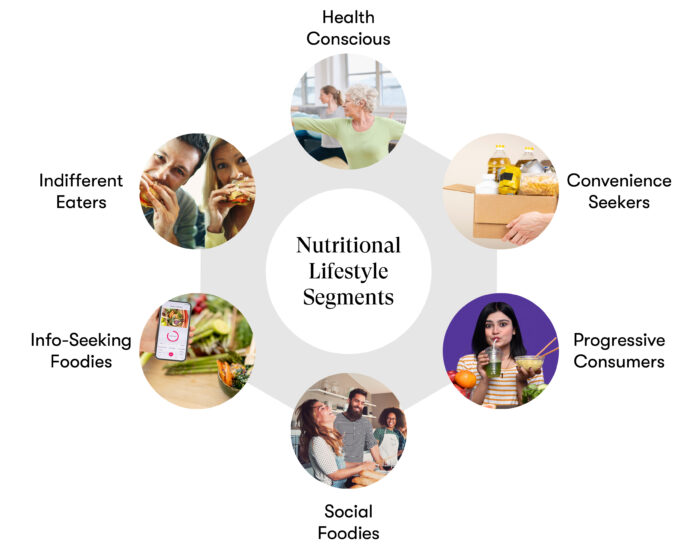Crowst palvelu
Mielipiteet & Asenteet
28/02/24Raising the Bar – Behavioral Segmentation on Insights
In the ever-evolving landscape of market research, understanding your audience has never been more critical. Traditional demographic targeting, while still useful, often falls short in capturing the complex nature of consumer behaviors and attitudes. At Crowst, we’re pioneering a more nuanced approach to consumer targeting for research. It leverages segmentation data to offer insights that transcend conventional boundaries. This enables businesses to identify, reach and connect to those audiences that are the most valuable to them.
Demographic Targeting in Consumer Research
Consumer research has traditionally relied on demographic targeting, categorizing people by age, gender, income, education, and other fixed attributes. This method is straightforward and offers a generalized picture of consumer segments. For example, a company selling high-end skincare products might target women aged 30-50 with above-average incomes, assuming they’re the most likely demographic to purchase premium skincare items.
However, demographic targeting has its limitations. It overlooks the diversity within demographic groups, assuming homogeneity in preferences and behaviors. For instance, not all women aged 30-50 will be interested in high-end skincare, nor will they all have the same purchasing power or lifestyle that aligns with the brand’s offerings.
Embracing Attitudinal and Behavioral Targeting
Recognizing these limitations, modern consumer research is increasingly focusing on attitudinal and behavioral targeting. This approach segments consumers based on their attitudes, interests, lifestyle choices, and actual behaviors rather than just demographic characteristics. It allows for a more dynamic understanding of what drives consumer decisions and how they interact with products and brands.
To illustrate the difference, let’s revisit the skincare brand example. Instead of researching broadly by age and income, the brand could use attitudinal and behavioral targeting to identify consumers who actively seek out premium health and beauty products, show a preference for sustainable and ethical brands, or regularly invest in self-care. This approach reveals the appeal of the brand to consumers, where the brand is more closely aligned with the consumer values and lifestyles.
Business Value from Segmentation based Research
The shift to behavioral segmentation offers a multifaceted view of the market. It leads to outcomes that are more aligned with consumer behavior. For example, in product development, using demographic reasearch aimed at women aged 20-30 yrs., a beverage company would discover a general concern for health. However, a segmented audience based reasearch focused on ”Fitness-focused Females” would reveal a high preference for natural sweeteners and performance-enhancing ingredients. This results in a product that precisely meets their health and fitness goals, resulting in higher adoption and customer satisfaction.
Such differences between demographic and segmentation research deliver direct business value across multiple business areas. This includes but is not limited to marketing, brand messaging, pricing, and more. It could be the difference between limited adoption in the market vs. higher adoption by targeted and engaged consumers.
Behavioral segmentation not only captures the diversity within consumer groups but also aligns products and marketing efforts with the specific values and behaviors of consumers. Thus, ultimately enhancing the efficacy of research and its application in real-world business scenarios.
Segmentation-Based Research with Crowst
At Crowst, utilizing data collected over 4 years, we have built a rich base of consumer segments for research targeting. Our dataset of over 18,500 Finns, segmented based on their attitudes towards food consumption, technology use, and fashion adoption, provides a goldmine of insights for businesses. They can leverage this data to tailor their products, marketing strategies, and business models to meet the nuanced needs of their target audiences. In effect, driving significant business impact through increased relevance and customer engagement.

Example consumer segmentation based on consumers’ association with food consumption. Representing over 18500 consumers in Finland. (Crowst)
Furthermore, in addition to the audiences Crowst has gathered, we have also implemented custom segments that are unique to our Customers. This has enabled them to research those segments directly through the Crowst platform. Please read our on how we enabled Vaasan Ltd. to research their custom segments in Finland.
“For us, audiences are much more than stereotypical buyer profiles. The audiences are formed by real people who live their lives, people who are motivated to express their views on our products and concepts, helping us to help them. We are thrilled to have these real-life audiences, helping us to develop even better products than before. The relevance of the audiences match and speed on sourcing insights with Crowst has been invaluable to us”
Mariana Liljeström, Research Manager at Vaasan Ltd. (2020)
The shift from demographic to attitudinal and behavioral targeting represents a significant evolution in consumer research. By understanding the complex tapestry of consumer behaviors and attitudes, businesses can engage with their audiences more effectively, crafting products and experiences that resonate on a deeper level. At Crowst, through segmentation targeting, we empower businesses with the insights needed to thrive in a competitive marketplace.